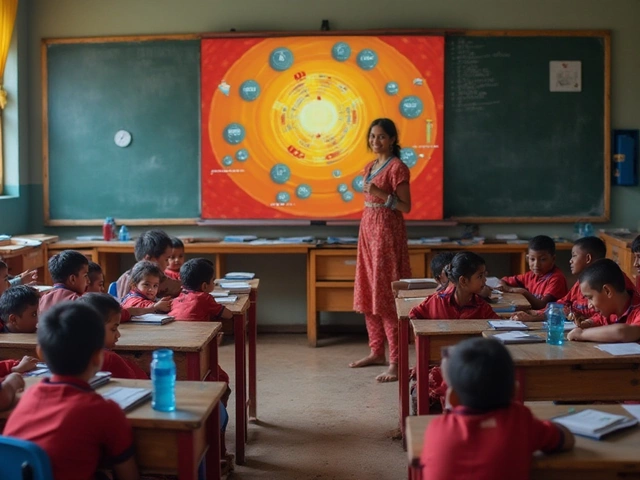Ever downloaded a 'free' app just to hit a paywall five minutes in? Yeah, it's super annoying, especially when you just want to learn something useful without your wallet getting involved. But here's the deal: finding an educational app that's totally, no-strings-attached free is possible—if you know where to look.
For starters, some apps really are legit. Khan Academy is the best example out there. Their entire library—math, science, history, you name it—is up for grabs without even asking for your credit card. No pop-ups asking you to go ‘pro’, no paid levels, nothing. It's free because they're backed by donations, which is honestly pretty cool.
If your kid needs help with homework or you want to brush up on algebra before a college exam, it's all there. The interface is super simple, and tons of teachers recommend it because, frankly, it works. Plus, they've got a Spanish version and stuff for parents, too. So while most learning apps love to tease 'free' only to lock away the good stuff, some, like Khan Academy, actually mean it.
- Understanding 'Totally Free' in Learning Apps
- Top Truly Free Educational Apps Right Now
- Why So Many Apps Aren't Really Free
- Getting the Most Out of Free Apps
- Tips to Avoid Hidden Costs
- What’s Next for Free E-Learning?
Understanding 'Totally Free' in Learning Apps
Okay, so what does free educational app really mean? It's not just an app you can download at no cost. Totally free means you get real, full learning app features—videos, exercises, quizzes—without ever being nagged for a subscription or hit with pay-per-feature walls.
Most apps you see on app stores flash the word 'free' in big letters, but here’s where they get tricky. Many offer a basic version without charge, then lock out the best free courses, practice tests, or progress tracking unless you pay. That's called a 'freemium' model. It’s everywhere, but it’s not the same as being totally free.
Here’s how to spot an app that’s truly free:
- No sign-up fees, no feature limits. Everything on the app is unlocked from the start.
- No trial period. You don’t get cut off or downgraded after a week.
- No sneaky in-app purchases. You won’t find random upgrade buttons in the middle of your lesson.
- No ads that make you watch videos or click banners between studies. Some free apps are loaded with these, which can kill your focus fast.
For example, Khan Academy ticks all these boxes. Their mission since 2008: keep everything free, forever. You never have to type in card details or watch five ads to unlock a video. Just pick a subject and start learning. According to a recent report, over 135 million people use Khan Academy every year, and the experience is still 100% free.
| App | Completely Free? | Ads | Account Required? |
|---|---|---|---|
| Khan Academy | Yes | No | Optional |
| Coursera | No (some courses free) | No | Yes |
| Duolingo | No (core free, ads, paid add-ons) | Yes | Yes |
Honestly, there aren’t a ton of apps in the e-learning world that are really, truly free. Most have some catch. That’s why, when you find one that is, it’s a game-changer—it’s the sort of thing that can help you or your kid level up, with nothing holding you back.
Top Truly Free Educational Apps Right Now
If you've ever searched for a free educational app and ended up frustrated, you're not alone. Luckily, a handful of platforms actually do the job without sneaky charges or surprise paywalls. Here are the best ones out there right now, each with their own strengths.
- Khan Academy: This is the gold standard for free courses across math, science, arts, and more. All videos and exercises are free, funded by donations and grants. You won’t find subscription prompts. Their app works great on both Android and iOS.
- Duolingo: Yep, language lovers get a major win. Duolingo lets you learn dozens of languages without paying a cent. Sure, you’ll see ads, but you can finish a whole course without ever needing to buy ‘hearts’ or upgrades. The endless daily streaks are a motivator by themselves.
- Coursera (Audit Mode): Here’s a little-known trick—on Coursera, you can "audit" a course for free. You don’t get the certificate, but you can still access lectures and assignments in a lot of classes from places like Yale and Google. Just look for the “audit” option at sign-up.
- Code.org: For anyone interested in coding—and parents of kids who want to start early—Code.org is awesome. All the basic puzzles, videos, and projects are genuinely free, making it one of the best choices among e-learning platforms for programming.
- TED: The TED app gives you thousands of bite-sized talks and lessons on everything from science breakthroughs to learning hacks. It’s 100% free—no catch, just knowledge from smart, interesting people worldwide.
Check out this handy overview of what these learning apps offer (as of April 2025):
| App Name | Main Subject | Completely Free? | Ads? | Certificate? |
|---|---|---|---|---|
| Khan Academy | All Subjects | Yes | No | No |
| Duolingo | Languages | Yes | Yes | No |
| Coursera (Audit Only) | Academic/Professional | Yes | No | No |
| Code.org | Programming | Yes | No | No |
| TED | General Knowledge | Yes | No | No |
For anyone who wants to learn something new without spending cash, these best free app picks deliver real value. The trick is to use features like offline downloads (Khan Academy offers this) and to skip bonuses like certificates if you don’t need them. This way, you can keep learning with zero cost—just your curiosity required.
Why So Many Apps Aren't Really Free
Ever wondered why most free educational app options end up asking for money? It's not a glitch. These apps need to pay their bills too—think about all those design updates, server costs, and the people making the learning content. Companies running e-learning platforms often use a 'freemium' model, which basically means you get a taste for free but have to pay for the main course.
Here’s how they usually play it:
- Locked lessons: You might get access to the basic parts, but extra chapters or advanced stuff are behind a paywall.
- Ad overload: Some apps show ads every few clicks, making it impossible to focus unless you upgrade to a paid version.
- Time limits: You can only learn for a set amount—once your 'daily limit' runs out, you have to wait or pay to keep going.
- Certificates and features: Some apps only give you proof of completion, teacher support, or quizzes if you cough up some cash.
Check out this quick look at how popular learning apps handle pricing:
| App Name | Free Content | What Isn't Free |
|---|---|---|
| Duolingo | Basic lessons | No-ads, unlimited hearts, mastery quizzes |
| Coursera | Auditing classes | Graded assignments, certificates |
| Quizlet | Study sets | Advanced games, offline access |
Another reason? Data. Some 'free' apps sell your usage info to make money without charging you upfront. So, when you spot a free course on a flashy app, peep the fine print. Truly best free app picks don't hide anything important or pile on annoying limits.

Getting the Most Out of Free Apps
Just using a free educational app isn’t enough—if you want real results, it helps to know a few tricks. The best part about platforms like Khan Academy is the way they’re organized. You don’t have to follow along like it’s a regular classroom. Jump ahead, switch subjects, and find the exact lesson you need.
Start by making a simple schedule so you keep at it. For example, pick 20 minutes after dinner for a quick practice session. Small, regular chunks beat marathon sessions every time. Mix it up, too. If you’re learning with kids, check out the app’s quizzes or video challenges together. Let’s be honest, it’s easier to stick to a routine if it’s not boring.
- Set up a profile—most free apps will let you track progress and pick up where you left off (no lost notes in random places).
- Use their app features, like discussion boards and hints, especially if you’re stuck.
- Let your friends or family know what you’re learning—teaching someone else can actually help you memorize stuff faster.
- Take the pre-tests if the app has one; you’ll see exactly where you need to work harder.
If you’re into stats, Khan Academy reported that in 2024 their active users spent an average of 25 minutes per session and mastered 20% more topics compared to the year before. That’s a solid bump and shows sticking to a simple routine really pays off.
| Tip | Benefit |
|---|---|
| Set learning reminders | Makes learning a habit |
| Use progress quizzes | Identifies knowledge gaps |
| Share your outcomes | Keeps motivation high |
One more thing: Don’t just take it from me. Sal Khan, founder of Khan Academy, said,
"Practice a little every day, use the mastery system to focus where you need the most help, and you'll move way faster than cramming all at once."
With smart habits and a bit of planning, free learning apps can take you a long way—without ever asking for your credit card details.
Tips to Avoid Hidden Costs
Just because an app shows up in the "free" section doesn’t mean you won’t end up paying later. Those sneaky fees and locked lessons catch a lot of people off guard. If you want a free educational app and not something that’s only free ’til you click the next button, there are a few tricks to keep in mind.
- Read Reviews First: People get pretty vocal when an app tricks them into buying stuff. Before you install, skim a few recent reviews to spot warnings about surprise costs.
- Check the App Description: On Google Play or the App Store, scroll all the way down to "In-app purchases." If you see a long list, there’s a good chance you’ll hit a paywall or ads.
- Try It Out: When you open the app, see how much you can actually use before they ask for money. Some apps let you access everything for a week, but then block it. Others, like Khan Academy, never ask for a dime.
- Watch for Upgrades: "Go Pro" or "Unlock full version" buttons are red flags if you want totally free. Even some e-learning platforms give you the basics and charge for certificates, extra lessons, or support.
- Be Wary of Trials: Lots of apps push free trials that end with an auto-charge. Mark your calendar or use a prepaid card so you don't get billed.
| App Name | Truly Free? | In-App Purchases? |
|---|---|---|
| Khan Academy | Yes | No |
| Duolingo | Partial | Yes |
| Coursera | No | Yes |
| EdX | Partial | Yes |
If you see ads popping up everywhere, that’s another warning sign. Sure, some apps stay free by showing ads, but sometimes they get so distracting you can't actually learn. It's better to use apps that are totally free or at least up-front about their model.
So, before you invest your energy in downloading a new learning tool, double-check what’s actually free. Keep an eye out for hidden fees, read the fine print, and stick to free courses that deliver what they promise. Your bank account will thank you.
What’s Next for Free E-Learning?
The world of free educational app options keeps changing, and it’s not slowing down anytime soon. These days, a lot of companies realize students, parents, and adults want honest, totally free ways to learn online. So, what can you expect soon?
First, more big organizations are stepping in to fund platforms like Khan Academy and open course providers. During the pandemic, Google Classroom and Microsoft Teams dropped in a bunch of free stuff for schools. Now, other companies are following their lead, especially in places where people can’t always pay for access. That means you’ll see a wider range of subjects and better features—still free—popping up on your phone or laptop.
Check out how this trend is growing, based on recent stats from early 2025:
| Platform | Users (2024) | Content Available | Cost |
|---|---|---|---|
| Khan Academy | 135 million | 11,000+ lessons | Free |
| Coursera (audit) | 56 million | 5,800 courses | Free (w/ limited features) |
| FutureLearn | 19 million | 2,000+ courses | Free (up to 8 weeks access) |
Some communities are also joining forces. Open source projects—like Moodle—are super popular in countries with tight education budgets. In India, the government wants all public school content digital and free by 2027, using apps and web platforms. More places are set to follow that blueprint.
Another thing to watch: people want their best free app options to work better offline and keep privacy tight. Developers are building lighter apps that need less data, which is a big win if your Wi-Fi is shaky.
So, what should you do to stay ahead? Simple:
- Check respected sites (like Common Sense Media or EdSurge) for lists of truly free e-learning platforms.
- Keep an eye out for local apps—sometimes the best stuff is built by teachers in your country.
- Don’t ignore privacy settings. The best free courses protect your info and don’t flood you with ads.
The main thing? It’s getting way easier to learn whatever you want, wherever you are—totally free. Free e-learning isn’t just a side option anymore; it’s starting to lead the way.







0 Comments